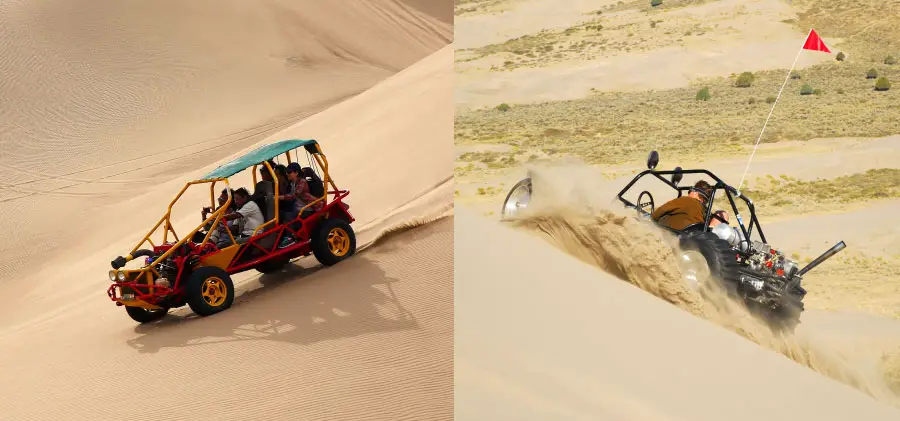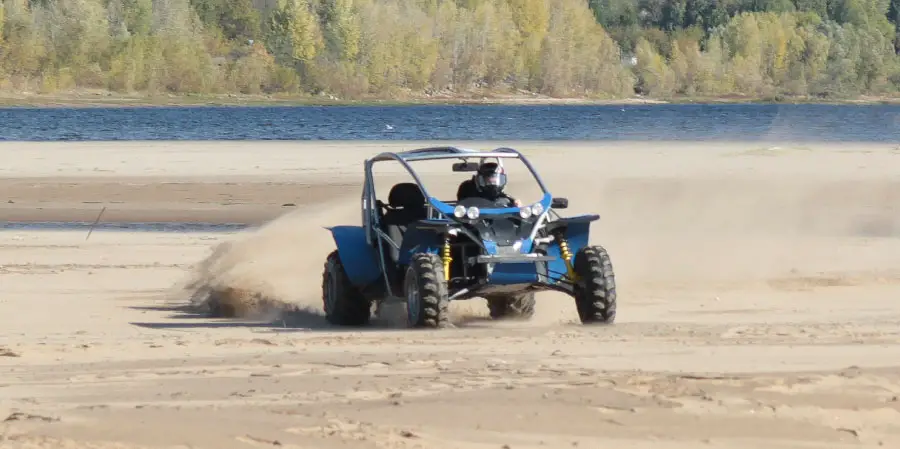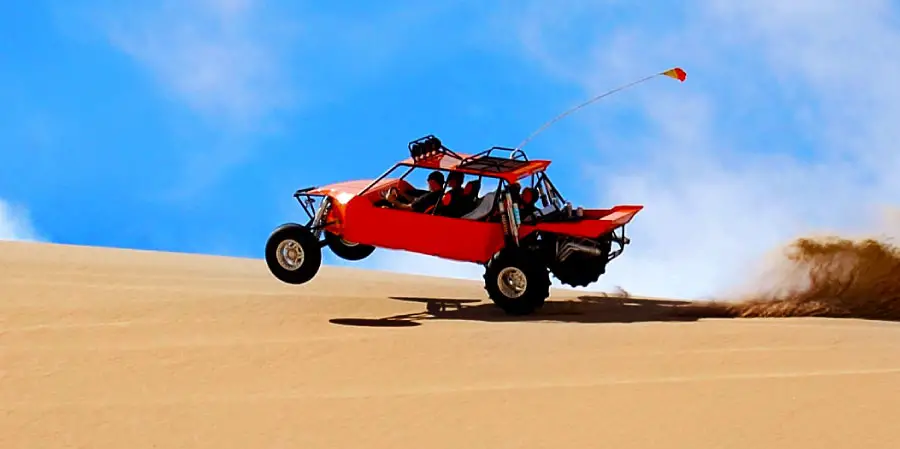
If you are an off-roading enthusiast and have access to dunes or sandy areas you will most likely have heard about sand rails and dune buggies. Have you ever wondered what the essential differences are between these two off-road vehicles?
There are 5 major differences between dune buggies and sand rails which include the way the vehicles are constructed, how much they cost, the tires they use, their engines, and whether they are, or can be, road legal or not.
Let’s investigate these differences in detail to help you make an informed decision with regards to which one is best suited for your needs.
Both vehicles are designed to operate in sandy conditions, but what would make you choose one over the other? Are there advantages and disadvantages between the two?
Everyone who has been to the beach, watched a surfing movie, or who is a fan of the Beach Boys, has seen a dune buggy parked at the beach with a couple of surfboards sticking up in the back seats! That is how the dune buggy also became known as the beach buggy. It almost received cult status in the 1970s and 1980s as the iconic surfer car!
In comparison, not many people have heard of a sand rail, or even know what it is! Yet the two vehicles have several similarities in design and function. The main difference in popularity is that the sand rail is pretty much a purpose-built vehicle and the dune buggy got all the social appeal!
There are 5 essential differences between the sand rail and the dune buggy, and we will go through them here. This information will clarify the main differences between the two and which one would suit your purposes when looking for a vehicle built for sandy conditions.
Construction
The difference in construction difference between the two vehicles is probably the greatest difference between the 5 we will consider.
The dune buggy is usually made from an existing car chassis. The most favored car to cannibalize for the construction of a dune buggy was traditionally the old Volkswagen (VW) Beetle. There are a few features of this car that made it popular as a choice for conversion into a dune buggy. The main features that made it a prime candidate were as follows.
- Solid construction. The Beetle was a robust, well-built car, and not only used as dune buggy conversions, but converted into rally cars as well.
- Short wheelbase. The short wheelbase made the car nice and compact, ideal for navigating sand dunes.
- Rear-mounted engine. The rear-mounted engine is a great design feature for a vehicle constructed for traversing sand. The weight in the backend helps to give traction for the rear wheels.
- Rear-wheel drive. The combination of the rear-mounted engine directly over the drive wheels makes for a more efficient, lighter drivetrain. Front-wheel drive vehicles typically don’t do well in sand. When the wheels turn, they start to push the sand sideways and much of the vehicle’s energy goes into this and results in getting stuck. The main drive wheels need to sty straight in sandy conditions.
A dune buggy usually has a fiberglass body fitted to it, so that it maintains some resemblance to a normal streetcar. Dune buggy conversions became so popular at one point that it spawned a whole industry around making fiberglass bodies for these conversions!
As part of the conversion of the VW Beetle, the roof was cut off, the doors removed, a roll bar is fitted and a modified windscreen. Wider tires were fitted and the body panels were all removed, and the fiberglass shell mentioned previously used instead. This reduced much of the weight of the vehicle. The result of the customization was an open, recreational vehicle that had great sand handling capability.
Sand rails are worlds apart in their construction when compared to their dune buggy counterparts! Sand rails do not start their life off as a streetcar. They start off their lives a pile of tube steel! In fact, they get their name from the tubular steel rails that they are made from.
Sand rails are custom built from the ground up. Their design, layout, and construction are all up to the builder. These vehicles are built with one purpose in mind; traveling over dunes and sandy off-road trails at high speed!
Their construction is an open design, with no body-panels or coverings to provide any protection from the elements or comfort for the driver. This type of construction however has the added advantage of being lightweight and easily repairable!
Depending on the budget of the creator, and the purpose of the vehicle, the type of metal used can become quite costly if lightweight durable material such as titanium is a requirement. Made of such material, the vehicle could be as light as 800 pounds! Typically, though, this type of construction is probably only within the budget of sponsored racing teams.
Sand rails can be constructed for two occupants, but have been built with only enough space for the driver. They have rear-mounted engines and usually have thinner wheels in front and fatter wheels at the back.
Sand rails are constructed with a low center of gravity, which is ideal for dune driving. The biggest problem with standard road vehicles is that they are top-heavy. This makes them very unstable in the steep angles often encountered when navigating sandy dunes!

Tires
In the aspect of tires, the sand rail definitely has an advantage over the dune buggy. The open construction of the sand rail does not confine the wheel hub close to the chassis. This design allows for the fitment of pretty much any size wheels on the vehicle that you could want! This flexibility allows for thinner wheels at the front and wider more voluminous tires at the back.
The wider tires at the back help to distribute the weight of the rear end of the vehicle more evenly over a wider area of sand. This is particularly helpful due to the placement of the engine at the rear of the vehicle, adding considerable weight to the back end.
Sand rails can accommodate specialized tires, called paddle tires that allow for better traction in the sand. Some builders have been known to fit the tires from farm implements that are designed for rugged conditions such as mud and sand.
Since dune buggies have been modified from street-legal cars, the design is limited to accept street-legal tires. The dune buggy design puts the wheels close to the chassis which limits the size of tires that can be fitted.
The limitation is both from a turning capacity aspect as well as the size limitation of the wheel well space of the chassis and bodywork.
While it is possible to fit large tires to the back of the dune buggy, the variation in size that can be fitted is considerably limited in comparison to the custom design of the sand rail.
Engine
Since sandrails are custom-built, the designer can create the vehicle to accommodate the engine of his choice. This opens up a variety of options regarding the size and power of the engine that it is possible to fit in one of these vehicles.
When sand rails first became a thing, you will be surprised to learn that the original engine of choice was that of the Volkswagen Beetle! You got it! The good old VW Beetle was once again the donor for another off-road vehicle! This was a good choice since the VW engine was air-cooled. The open style construction of the sand rail made sure there was plenty of air available to cool the engine!
Since then, other engines have been brought into service in the sand rail, from Chevy engines to Cosworth engines and even Porsche engines have been used. Having additional power is a huge advantage when dune driving. It is often just the brute force of the motor that drives the vehicles to the top, not allowing it to be in one place long enough to sink into the sand and get stuck!
The dune buggy, in contrast, is limited to the size engine that can be fitted. The limitation is largely due to the constraint of the available space in the engine bay of the chassis. The engine space can be modified to accept a slightly bigger engine than the standard VW motor, but not enough to fit a significantly larger engine!
This could be seen as a limitation of the dune buggy, but it has not stopped owners of these vehicles successfully using them in the dunes. It may just limit the dune buggy as to the steepness of the dunes that it can traverse!
Cost
The VW Beetle dune buggy conversion was the subject of many home garage projects back in the dune buggy heyday! That is an indication that the project is within the capacity and budget of most off-road enthusiasts.
The biggest problem that the aspiring modern-day, home garage, dune buggy conversion enthusiast would face is the availability of parts. The production of the old-style VW Beetle was discontinued in 2003. This makes the chassis and engines highly desirable for conversion purposes and has started driving up the prices. That is if you can even source them at all! This problem will get worse rather than better, till that point that they are simply no longer available.
Other vehicle chassis have been used to create dune buggies, but they generally need a much larger degree of modification. This increases the work needed to do the conversion, which in turn increases the cost.
The cost of conversion into a dune buggy or buying a dune buggy that has already been converted is significantly cheaper than building or buying a sand rail.
Due to the level of expertise required in designing and building a custom vehicle from scratch, the costs already start outstripping that of a dune buggy. All the raw materials need to be sourced, cut, and welded. Specialist material is often used in the creation of sand rails, which ups the cost significantly. These non-standard materials often require specialized tools and knowledge to work with them.
Another aspect that contributes to the greater cost of producing a sand rail is the time that it takes to build from raw materials. The dune buggies conversions have the advantage here, as many of the components come pre-assembled or manufactured. The chassis is already complete, the pre-molded fiberglass body comes complete, and so on. This makes for a much faster and cheaper construction for the dune buggy than building a sand rail from scratch.
You can find pre-built sand rails for purchase, but their purchase price is still significantly higher due to the man-hours and materials that went into the build.

Are they Road Legal?
This aspect is another difference between a dune buggy and a sand rail that may influence your decision making regarding which is better for you.
The dune buggy definitely edges out the sand rail in this department. Because a dune buggy is built on the base of a previously street-legal car, it only requires minor modifications to make it legal once again for the streets!
This advantage makes the dune buggy very much a dual-purpose vehicle. It can be used for off-road sun on the weekend and still drive you to work or school during the week! This may be a determining factor regarding your choice of an off-road vehicle. It also means that you can actually drive your dune buggy out to the place where you are going to enjoy some fun in the sand!
The sand rail is most definitely not street legal. The very nature of its custom design for the purpose of sand and dune driving means that it is not built according to legal standards of normal streetcars.
Sand rails usually have no brae lights, turning indicators, and no headlights. The designs have also not undergone stringent safety and crash testing to make sure they are suitable to be on public roads. The tires fitted to these vehicles and also usually not acceptable for street driving.
These factors mean that you cannot drive your sand rail to your off-roading location. You will need to transport it to the location on a trailer, which is an additional cost related to owning a sand rail.
Retrieval Gear
A situation that is going to be inevitable in sand or dune off-roading is that you are going to get stuck at some point! That is just the nature of the activity. In preparation for this eventuality, it is wise to have the appropriate and good quality gear necessary to get yourself or others out of such situations.
There are many tools and equipment that are purpose-built to extricate vehicles from the sand, but that it the topic for another article. Just be aware that you will need to include the cost of rescue and retrieval gear when purchasing your off-road vehicle!
Conclusion
In conclusion, although both dune buggies and sand rails are used for similar purposes, you can now see how different they are as off-road vehicles and it’s up to you to decide which one is best suited for your particular needs when it comes to taking on the dunes or other sandy places. As long as you remember to stay safe and have fun!
Happy dune bashing!


